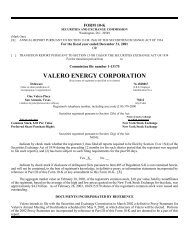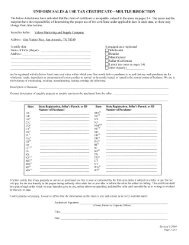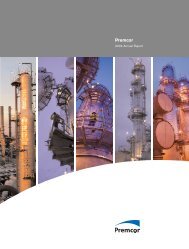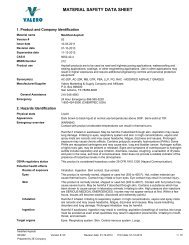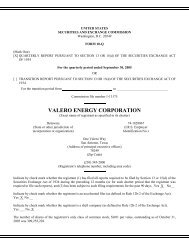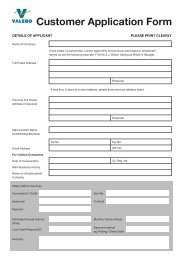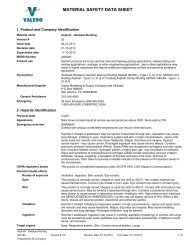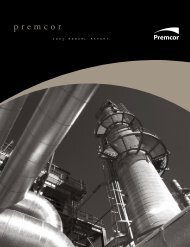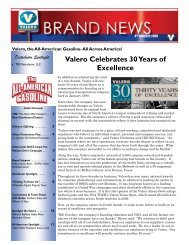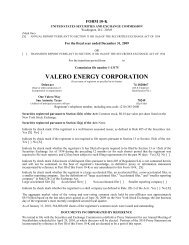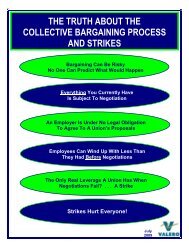Aromatic Concentrate-420 - Valero
Aromatic Concentrate-420 - Valero
Aromatic Concentrate-420 - Valero
Create successful ePaper yourself
Turn your PDF publications into a flip-book with our unique Google optimized e-Paper software.
Fire fighting<br />
equipment/instructions<br />
Specific methods<br />
Hazardous combustion<br />
products<br />
Wear full protective clothing, including helmet, self-contained positive pressure or pressure<br />
demand breathing apparatus, protective clothing and face mask. Withdraw immediately in case of<br />
rising sound from venting safety devices or any discoloration of tanks due to fire. Fight fire from<br />
maximum distance or use unmanned hose holders or monitor nozzles. Move containers from fire<br />
area if you can do it without risk. In the event of fire, cool tanks with water spray. Cool containers<br />
exposed to flames with water until well after the fire is out. For massive fire, use unmanned hose<br />
holders or monitor nozzles; if this is impossible, withdraw from area and let fire burn. Vapors may<br />
form explosive air mixtures even at room temperature. Prevent buildup of vapors or gases to<br />
explosive concentrations. Some of these materials, if spilled, may evaporate leaving a flammable<br />
residue. Water runoff can cause environmental damage. Use compatible foam to minimize vapor<br />
generation as needed.<br />
In the event of fire and/or explosion do not breathe fumes. Use water spray to cool unopened<br />
containers.<br />
Carbon monoxide. Carbon Dioxide. Sulfur oxides. Nitrogen oxides (NOx). Hydrocarbons.<br />
6. Accidental Release Measures<br />
Personal precautions<br />
Environmental precautions<br />
Methods for containment<br />
Methods for cleaning up<br />
Keep unnecessary personnel away. Local authorities should be advised if significant spills cannot<br />
be contained. Keep upwind. Keep out of low areas. Ventilate closed spaces before entering. Do<br />
not touch damaged containers or spilled material unless wearing appropriate protective clothing.<br />
See Section 8 of the MSDS for Personal Protective Equipment.<br />
If facility or operation has an "oil or hazardous substance contingency plan", activate its<br />
procedures. Stay upwind and away from spill. Wear appropriate protective equipment including<br />
respiratory protection as conditions warrant. Do not enter or stay in area unless monitoring<br />
indicates that it is safe to do so. Isolate hazard area and restrict entry to emergency crew.<br />
Flammable. Review Firefighting Measures, Section 5, before proceeding with clean up. Keep all<br />
sources of ignition (flames, smoking, flares, etc.) and hot surfaces away from release. Contain<br />
spill in smallest possible area. Recover as much product as possible (e.g. by vacuuming). Stop<br />
leak if it can be done without risk. Use water spray to disperse vapors. Use compatible foam to<br />
minimize vapor generation as needed. Spilled material may be absorbed by an appropriate<br />
absorbent, and then handled in accordance with environmental regulations. Prevent spilled<br />
material from entering sewers, storm drains, other unauthorized treatment or drainage systems<br />
and natural waterways. Contact fire authorities and appropriate federal, state and local agencies.<br />
If spill of any amount is made into or upon navigable waters, the contiguous zone, or adjoining<br />
shorelines, contact the National Response Center at 1-800-424-8802. For highway or railways<br />
spills, contact Chemtrec at 1-800-424-9300.<br />
Eliminate all ignition sources (no smoking, flares, sparks, or flames in immediate area). Stop leak<br />
if you can do so without risk. This material is a water pollutant and should be prevented from<br />
contaminating soil or from entering sewage and drainage systems and bodies of water. Dike the<br />
spilled material, where this is possible. Prevent entry into waterways, sewers, basements or<br />
confined areas.<br />
Use non-sparking tools and explosion-proof equipment.<br />
Small Spills: Absorb spill with vermiculite or other inert material, then place in a container for<br />
chemical waste. Clean surface thoroughly to remove residual contamination. This material and its<br />
container must be disposed of as hazardous waste.<br />
Other information<br />
Large Spills: Use a non-combustible material like vermiculite, sand or earth to soak up the product<br />
and place into a container for later disposal. Prevent product from entering drains. Do not allow<br />
material to contaminate ground water system. Should not be released into the environment.<br />
Clean up in accordance with all applicable regulations.<br />
7. Handling and Storage<br />
Handling<br />
Storage<br />
Wear personal protective equipment. Do not breathe gas/fumes/vapor/spray. Avoid contact with<br />
eyes, skin, and clothing. Do not taste or swallow. Avoid prolonged exposure. Use only with<br />
adequate ventilation. Wash thoroughly after handling. The product is extremely flammable, and<br />
explosive vapor/air mixtures may be formed even at normal room temperatures. DO NOT handle,<br />
store or open near an open flame, sources of heat or sources of ignition. Protect material from<br />
direct sunlight. Take precautionary measures against static discharges. All equipment used when<br />
handling the product must be grounded. Use non-sparking tools and explosion-proof equipment.<br />
When using, do not eat, drink or smoke. Avoid release to the environment.<br />
Flammable liquid storage. Do not handle or store near an open flame, heat or other sources of<br />
ignition. This material can accumulate static charge which may cause spark and become an<br />
ignition source. The pressure in sealed containers can increase under the influence of heat. Keep<br />
container tightly closed in a cool, well-ventilated place. Keep away from food, drink and animal<br />
feedingstuffs. Keep out of the reach of children.<br />
<strong>Aromatic</strong> <strong>Concentrate</strong><br />
900670<br />
Prepared by 3E Company<br />
Version #: 03<br />
Revison date: 11-13-2012 Print date: 11-13-2012<br />
CPH MSDS NA<br />
3 / 12





